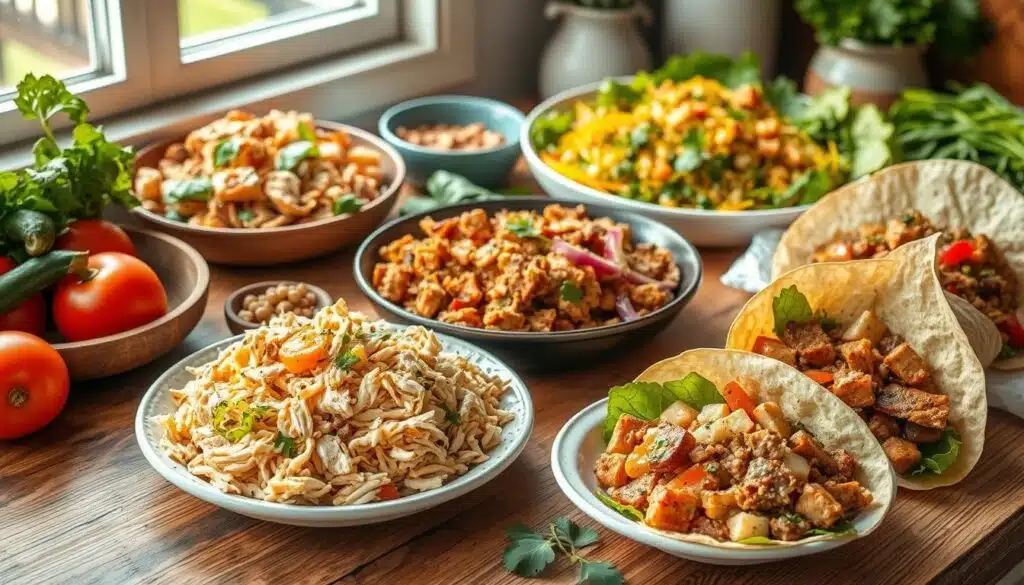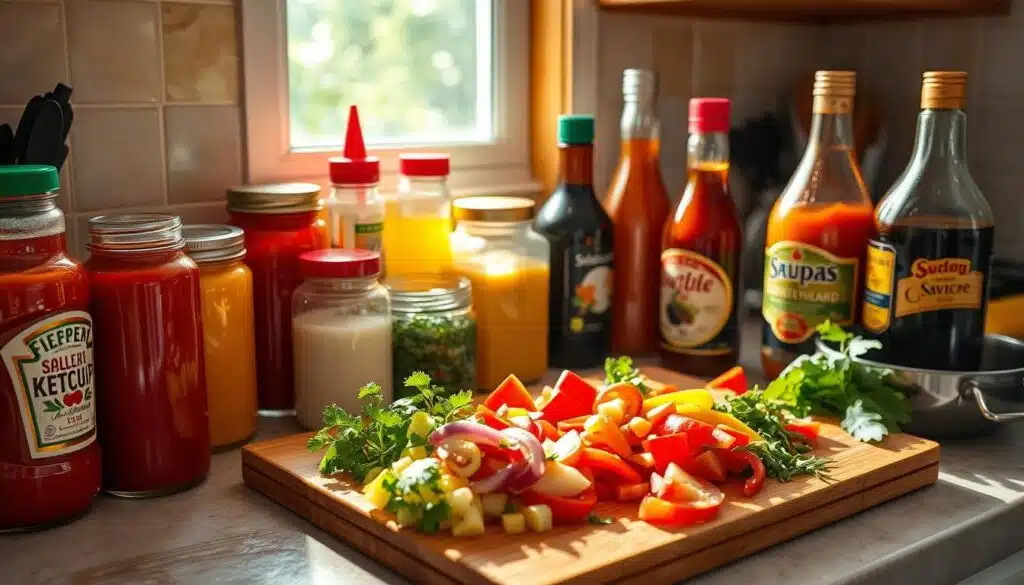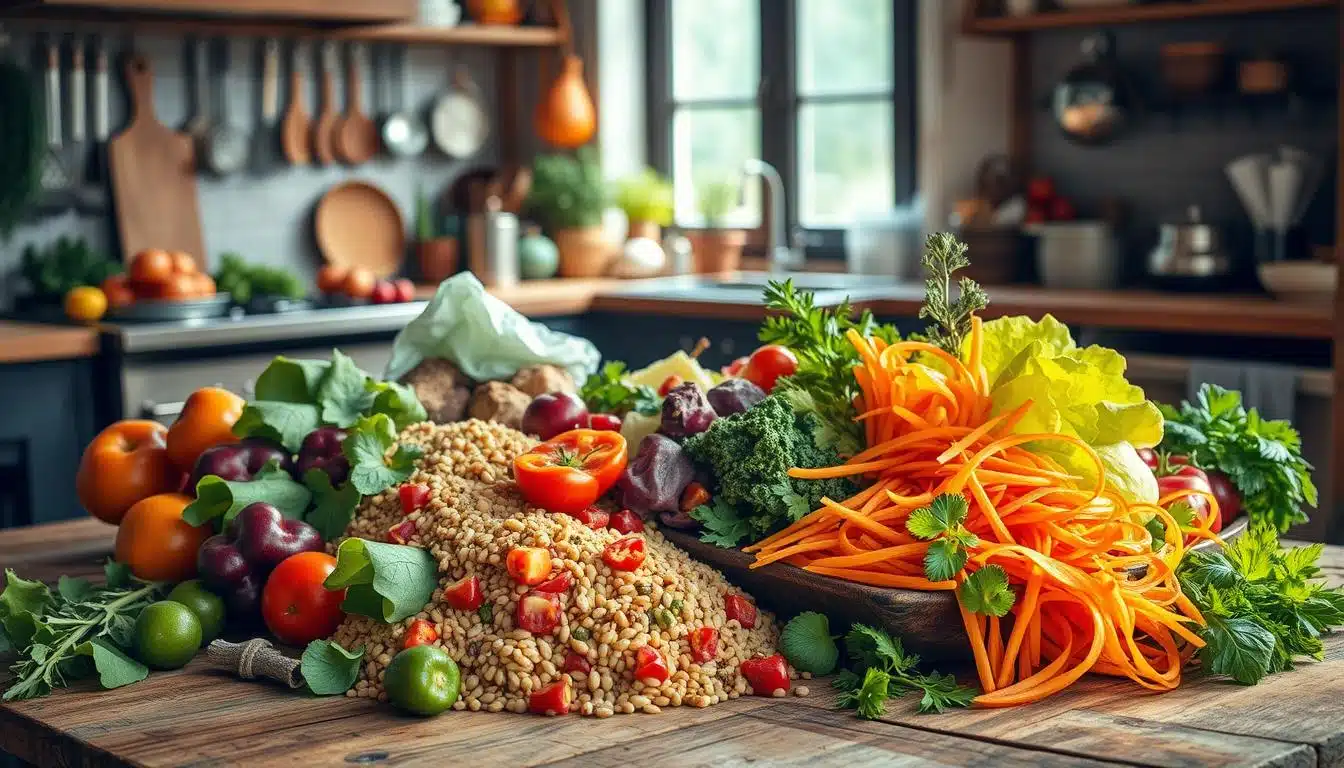Have you ever opened your fridge and found an item you didn’t realize was there? You’re not alone! 44% of Americans have found an item in their fridge in the past month that they didn’t realize was there. This raises a question: what if we could reduce food waste and save money by using up these leftover ingredients? With a little creativity, we can turn last night’s dinner into tomorrow’s lunch, and that’s exactly what we’ll explore in this article, focusing on creative ways to reuse leftover ingredients and cooking with leftovers to make delicious leftover ingredient recipes.
According to the National Resources Defense Council, up to 40% of food grown, processed, and transported in the U.S. will never be eaten. This staggering statistic highlights the importance of reducing food waste. By using creative ways to reuse leftover ingredients, we can make a significant impact. So, let’s get started on this journey to reduce food waste and create tasty meals using leftover ingredient recipes and creative ways to reuse leftover ingredients!
As we delve into the world of creative cooking with leftovers, we’ll discover the benefits of reusing ingredients, from saving money to reducing our environmental footprint. With the help of tools like BigOven, we can find recipes based on ingredients we already have, making it easier to cook with leftovers and reduce food waste. So, what are you waiting for? Let’s start cooking with creative ways to reuse leftover ingredients and make a difference, one meal at a time, using leftover ingredient recipes and cooking with leftovers.
Key Takeaways
- Reduce food waste by using creative ways to reuse leftover ingredients
- Save money by cooking with leftovers and making leftover ingredient recipes
- Make a positive impact on the environment by reducing food waste
- Discover new recipes and cooking ideas using leftover ingredients
- Use tools like BigOven to find recipes based on ingredients you already have
- Get creative with leftover ingredient recipes and cooking with leftovers to reduce food waste
- Start cooking with creative ways to reuse leftover ingredients and make a difference
Introduction to Creative Cooking
As I delve into the world of cooking, I realize the importance of reducing food waste and exploring sustainable cooking methods. According to the U.S. Department of Agriculture (USDA), 30–40% of the food supply in the United States is wasted each year. This staggering statistic motivates me to find creative ways to reuse leftover ingredients and reduce food waste.
By embracing sustainable cooking practices, we can make a significant impact on the environment. For instance, making vegetable stock from scraps can help reduce waste, while composting food scraps generates nutrient-rich compost that enriches soil and promotes plant growth. I’ve also discovered that freezing leftover herbs and regrowing vegetables in water can help preserve them for future use.
As I continue on this journey, I’ve come across various methods for repurposing food scraps, such as making scrap vinegar from fruit scraps or using brine from fermented pickles for marinating meat. These creative approaches to reducing waste in cooking have inspired me to think outside the box and explore new leftover meal ideas. By adopting these sustainable cooking practices, we can not only reduce food waste but also create delicious and unique dishes.
Importance of Reducing Food Waste
Reducing food waste is crucial for a sustainable future. By reusing leftover ingredients, we can conserve natural resources, reduce the amount of waste sent to landfills, and promote environmentally friendly practices. This approach to cooking also encourages creativity and experimentation in the kitchen, leading to new and exciting sustainable cooking experiences.
Benefits of Reusing Ingredients
The benefits of reusing ingredients are numerous. Not only can we reduce food waste, but we can also save money on grocery expenses and create nutritious meals. By getting creative with leftover ingredients, we can discover new flavors and recipes, making the cooking process more enjoyable and rewarding. As we explore the world of sustainable cooking, we can make a positive impact on the environment and our communities, one delicious meal at a time.
Transforming Leftover Vegetables into Dishes
I love experimenting with new recipes, and one of my favorite ways to get creative in the kitchen is by cooking with leftovers. Not only does it help reduce food waste, but it also saves me money and time. One of the most versatile ingredients to work with is leftover vegetables. From utilizing kitchen scraps to make a delicious vegetable broth to turning last night’s dinner into a tasty frittata, the possibilities are endless.
Here are some leftover food hacks to get you started:
- Make a quick and easy vegetable stir-fry with your favorite ingredients and sauces.
- Simmer leftover vegetables in a flavorful broth to create a comforting soup.
- Add leftover vegetables to a frittata or omelette for a nutritious breakfast.
By getting creative with leftover vegetables, you can reduce food waste, save money, and enjoy delicious meals without breaking the bank. So next time you’re about to throw away those leftover veggies, think twice and get cooking!
| Leftover Vegetable | Recipe Idea |
|---|---|
| Carrots | Carrot and ginger soup |
| Broccoli | Broccoli and cheese frittata |
| Spinach | Spinach and mushroom stir-fry |
Reimagining Leftover Grains
As I explore the world of leftover ingredient recipes, I’m excited to share my discoveries on reimagining leftover grains. Cooking with leftovers is not only a great way to reduce food waste, but it also allows us to get creative in the kitchen. With a little experimentation, we can turn yesterday’s leftovers into today’s delicious meals.
According to BigOven, using leftover grains to make a grain bowl or adding them to salads for extra texture and nutrition is a fantastic way to reduce food waste. By incorporating leftover grains into our meals, we can create a variety of dishes that are both healthy and flavorful. For instance, we can make a grain bowl with roasted vegetables, or add cooked quinoa to our favorite salads for a nutritious boost.
Grain Bowls for Meal Prep
Grain bowls are an excellent way to meal prep, as they can be customized with a variety of ingredients. We can add leftover grains to a bowl, top it with our favorite vegetables, and finish it off with a tangy dressing. This not only reduces food waste but also provides a quick and easy meal solution.
Using Grains in Salads
Adding grains to salads is another great way to reuse leftover ingredients. We can mix cooked grains with fresh vegetables, nuts, and seeds to create a hearty and healthy salad. This approach not only reduces food waste but also provides a nutritious and filling meal option.
By embracing leftover ingredient recipes and cooking with leftovers, we can make a significant impact on reducing food waste. According to the Department of Agriculture, between 30% and 40% of food in the U.S. is wasted annually. By incorporating leftover grains into our meals, we can do our part in reducing this staggering statistic and promoting sustainability in the kitchen.
| Leftover Grain Ideas | Meal Prep Options |
|---|---|
| Grain bowls | Customizable with various ingredients |
| Salads with grains | Mix with fresh vegetables, nuts, and seeds |
| Grain burgers | Delicious and nutritious alternative to traditional burgers |
How to Repurpose Proteins
When it comes to sustainable cooking, one of the most effective ways to reduce food waste is by repurposing proteins. This can be achieved by utilizing kitchen scraps and applying clever leftover food hacks. For instance, leftover chicken can be used to make delicious tacos or added to a hearty soup for a comforting meal.
Some ideas for repurposing proteins include using chicken in tacos, creating savory pasta dishes with leftover beef or pork, or adding protein to leftover recipes with pantry staples like canned beans or chickpeas. By adopting these strategies, individuals can minimize food waste and create tasty, sustainable cooking options.

Additionally, utilizing kitchen scraps can be as simple as storing leftovers properly and reheating them in the oven or air fryer instead of the microwave. This helps preserve the taste and texture of the food, making it more enjoyable to eat. By applying these leftover food hacks and embracing sustainable cooking practices, anyone can reduce food waste and create delicious meals with ease.
Innovative Uses for Fruit Scraps
As I continue to explore creative ways to reuse leftover ingredients, I am excited to share some innovative uses for fruit scraps. By cooking with leftovers and reducing food waste, we can make a significant impact on the environment and our wallets. Did you know that the average American household tosses up to $2,000 worth of food every year?
One of my favorite ways to reuse fruit scraps is to make flavorful smoothies. I simply add the scraps to my blender along with some yogurt and milk, and blend until smooth. This is a great way to reduce food waste and create a healthy and delicious drink. Another idea is to create homemade fruit marmalade using fruit scraps. This is a simple process that involves cooking the scraps with some sugar and water to create a sweet and tangy preserve.
Here are some other ideas for using fruit scraps:
- Make infused water by adding fruit scraps to a pitcher of water
- Use fruit scraps to make homemade fruit leather
- Add fruit scraps to your favorite baked goods, such as muffins or cakes
By getting creative with fruit scraps, we can reduce food waste and create delicious and healthy treats. So next time you’re about to throw away those fruit scraps, think twice and get creative!
| Fruit Scrap | Use |
|---|---|
| Apple cores | Make apple cider vinegar |
| Orange peels | Make homemade marmalade |
| Watermelon rinds | Make pickled watermelon rinds |
Reusing Dairy Products Smartly
As I explore ways to reduce food waste, I’ve discovered that dairy products like milk, cheese, and yogurt can be reused in a variety of dishes, from soups to baked goods, and from salads to smoothies. This approach to sustainable cooking not only reduces waste but also encourages creativity in the kitchen.
Using leftover milk to make a creamy soup or as a base for homemade yogurt are just a couple of examples of how we can apply leftover ingredient recipes to our daily cooking. BigOven provides ideas for reusing dairy products, such as turning milk into creamed soups or using cheese to make a crust for baking, which aligns perfectly with the concept of cooking with leftovers.
- Turning sour milk into buttermilk for pancakes or waffles
- Using cheese to make a crust for baking, adding a rich flavor to dishes
- Creating yogurt salad dressings for a healthy and tangy twist on traditional dressings
These simple changes can significantly impact our approach to food waste and contribute to a more sustainable kitchen practice.
Creative Ways to Utilize Leftover Breads
When it comes to reducing food waste, one of the most overlooked ingredients is leftover bread. Instead of throwing it away, we can get creative and turn it into delicious dishes. By utilizing kitchen scraps like leftover bread, we can reduce food waste and create new leftover meal ideas.
There are many ways to breathe new life into stale bread. For example, we can use it to make bread pudding, a classic dessert that’s perfect for using up leftover bread. We can also turn it into crunchy croutons for salads or use it to make flavorful bruschetta. The possibilities are endless, and it’s a great way to reduce food waste and get creative in the kitchen.
Here are some ideas to get you started:
- Make a bread pudding with leftover bread and your favorite ingredients, such as nuts, chocolate chips, or dried fruit.
- Turn leftover bread into crunchy croutons for salads or soups.
- Use leftover bread to make flavorful bruschetta, topped with fresh tomatoes, basil, and mozzarella cheese.
By utilizing leftover bread, we can reduce food waste and create new and exciting dishes. So next time you’re about to throw away stale bread, think twice and get creative! Reducing food waste is a great way to make a positive impact on the environment, and it can also help you save money and get creative in the kitchen.
Repurposing Sauces and Condiments
When it comes to cooking with leftovers, we often think about reusing main ingredients like vegetables, proteins, and grains. However, sauces and condiments can also be repurposed in creative ways to reduce food waste and add flavor to our dishes. By adopting sustainable cooking practices, we can make a significant impact on the environment and our wallets.
One way to repurpose sauces and condiments is to use them as marinades for meats or as flavor boosts for soups and stews. For example, leftover soy sauce or ketchup can be used to create a marinade for chicken or beef, while leftover tomato sauce can be added to soups or stews for extra flavor. These leftover food hacks can help reduce food waste and add variety to our meals.
Here are some ideas for repurposing sauces and condiments:
- Use leftover sauces as dips for vegetables or crackers
- Add leftover condiments to soups or stews for extra flavor
- Use leftover marinades as sauces for grilled meats or vegetables

By getting creative with sauces and condiments, we can reduce food waste and add flavor to our dishes. Remember, cooking with leftovers is all about thinking outside the box and finding new ways to use up ingredients. With a little practice, you can become a master of sustainable cooking and reduce your environmental impact.
| Sauce/Condiment | Repurposing Idea |
|---|---|
| Leftover soy sauce | Use as a marinade for chicken or beef |
| Leftover ketchup | Add to soups or stews for extra flavor |
| Leftover tomato sauce | Use as a sauce for pasta or pizza |
Crafting Unique Snacks from Leftovers
As I explore the world of creative cooking, I’m excited to share my favorite ways to reuse leftover ingredients and reduce food waste. One of my favorite things to do is to craft unique snacks from leftovers. Not only does this help reduce food waste, but it also allows me to get creative in the kitchen and come up with new, delicious flavors.
For example, I love using leftover ingredients to make nutritious energy balls. These no-bake bites are perfect for a quick snack or post-workout treat. I also enjoy creating savory veggie chips using leftover vegetables. Simply slice the veggies thin, toss with oil and seasoning, and bake until crispy. These chips are a great way to reduce food waste and enjoy a healthy snack.
Some other ideas for using leftover ingredients to make unique snacks include:
- Making sweet treats like cookies or brownies using leftover fruit or nuts
- Creating a trail mix using leftover nuts, seeds, and dried fruit
- Using leftover cheese to make a cheesy dip or spread
By getting creative with leftover ingredients, we can reduce food waste and enjoy delicious, unique snacks. So next time you’re about to throw away leftover ingredients, think twice and see if you can come up with a new, tasty snack instead!
| Leftover Ingredient | Unique Snack Idea |
|---|---|
| Leftover fruit | Make a fruit salad or use in a smoothie |
| Leftover vegetables | Make savory veggie chips or use in a stir-fry |
| Leftover cheese | Make a cheesy dip or spread |
Fast and Easy Soups from Leftovers
When it comes to cooking with leftovers, one of the most convenient and delicious options is to make fast and easy soups. Not only does this help reduce food waste, but it also allows for sustainable cooking practices. By using leftover ingredients, you can create a variety of soups that are both healthy and tasty.
Some ideas for fast and easy soups from leftovers include:
- Classic leftover veggie soup
- Protein-packed bean soup
- Hearty potato soup
These soups can be made by combining leftover vegetables, proteins, and grains, and then adding some broth and seasoning. You can also customize your soups by adding different spices, herbs, or other ingredients to suit your taste.
To make your soups even more convenient, consider making double batches and freezing individual portions for later use. This way, you can enjoy a quick and easy meal whenever you want, while also reducing food waste and practicing sustainable cooking.
By incorporating cooking with leftovers into your meal routine, you can make a positive impact on the environment while also enjoying delicious and healthy meals. So next time you have leftover ingredients, consider making a fast and easy soup to reduce food waste and practice sustainable cooking.
| Soup Recipe | Leftover Ingredients | Prep Time |
|---|---|---|
| Classic Leftover Veggie Soup | Leftover vegetables, broth, seasoning | 15 minutes |
| Protein-Packed Bean Soup | Leftover beans, vegetables, broth, seasoning | 20 minutes |
| Hearty Potato Soup | Leftover potatoes, vegetables, broth, seasoning | 25 minutes |
Tips for Storing Leftover Ingredients
When it comes to cooking with leftovers, proper storage is essential to maintain the quality and safety of the ingredients. By following some simple tips, you can enjoy your leftover ingredient recipes for a longer period while embracing sustainable cooking.
To start, it’s crucial to use airtight containers to store leftovers in the fridge or freezer. This helps to prevent spoilage and keep the ingredients fresh. You can also use freezer bags or containers to store leftovers for longer periods.
Here are some additional tips for storing leftover ingredients:
- Label the containers with the date and contents to ensure easy access and identification.
- Store leftovers in the refrigerator at a temperature of 40°F (4°C) or below.
- Freeze leftovers at 0°F (-18°C) or below to prevent the growth of harmful bacteria.
By following these tips, you can enjoy your leftover ingredient recipes while reducing food waste and embracing sustainable cooking. Remember to always check the leftovers for spoilage before consuming them to ensure food safety.
With a little planning and creativity, you can turn leftover ingredients into delicious and sustainable meals. Start exploring the world of leftover ingredient recipes and discover the benefits of cooking with leftovers!
| Storage Method | Temperature | Shelf Life |
|---|---|---|
| Refrigeration | 40°F (4°C) | 3-5 days |
| Freezing | 0°F (-18°C) | 3-6 months |
Conclusion: Embrace Creativity in the Kitchen
As we conclude our exploration of creative ways to reuse leftover ingredients, it’s clear that embracing a more sustainable approach to cooking can have a significant impact. By reducing food waste, we not only save money but also contribute to a healthier planet. Modern pressure cookers, for instance, can reduce cooking time by up to 70%, making it easier to transform scraps into delicious meals.
Sustainable cooking promotes a closer relationship between the food we consume and the environment through ethical sourcing and thoughtful preparation. Kitchens contribute significantly to environmental footprints due to high water and energy consumption, so incorporating sustainability into our daily routines can make a real difference. Simple steps like using digital documents over printing can help minimize paper waste, while engaging in community initiatives like swap meets can foster a culture of reuse within our local areas.
Remember, the key to reducing food waste is to get creative in the kitchen. By reusing leftover ingredients, you not only save money but also hone your culinary skills and minimize your environmental impact. Teach your children about recycling and upcycling practices, and encourage them to explore the endless possibilities of transforming scraps into tasty treats. With a little imagination and dedication, you can embark on a journey of sustainable cooking that benefits both your wallet and the planet.

